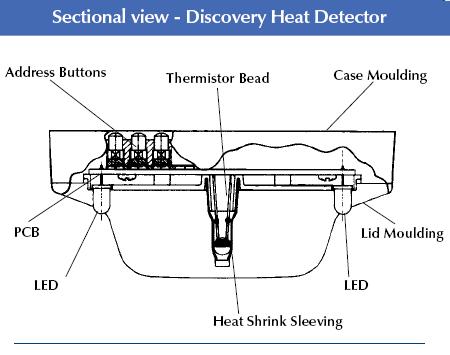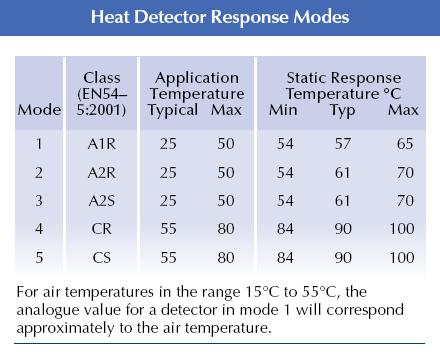DISCOVERY, Тепловые детекторы, 58000-400
 | Тепловые детекторы, |
Operating Principles
Discovery heat detectors have a common profile with ionisation and optical smoke detectors but have a low air flow resistance case made of selfextinguishing white polycarbonate.
The Discovery Heat Detector uses a single thermistor to sense the air temperature at the detector position.
The thermistor is connected in a resistor network, which produces a voltage output dependent on temperature. The design of the resistor network, together with the processing algorithm in the microcontroller, gives an approximately linear characteristic from 10°C to 80°C.
This linearised signal is further processed, depending on the response mode selected, and converted to an analogue output.
For the European standard version of the detector, the five modes correspond to five “classes” as defined in EN54–5:2001. The classes in this standard correspond with different response behaviour, each of which is designed to be suitable for a range of application temperatures. All modes incorporate “fixed temperature” response, which is defined in the standard by the “static response temperature”. The application temperatures and static response temperatures for all response modes are given in Table 6.
In addition to the basic classification, a detector may be given an “R” or “S” suffix. The “R” suffix indicates that the detector has been shown to have a rateof- rise characteristic. Such a detector will still give a rapid response even when starting from an ambient temperature well below its typical application temperature. This type of detector is therefore suitable for areas such as unheated warehouses in which the ambient temperature may be very low for long periods.
The “S” suffix on the other hand indicates that the detector will not respond below its minimum static response temperature even when exposed to high rates of rise of air temperature. This type is therefore suitable for areas such as kitchens and boiler rooms where large, rapid temperature changes are considered normal.
ТЕХНИЧЕСКИЕ ХАРАКТЕРИСТИКИ
| Detection principle: | Heat sensitive resistance. |
| Supply wiring: | Two-wire supply, polarity insensitive |
| Radioactive isotope: | Americium 241 |
| Terminal functions: | L1 & L2 supply in and out connections +R remote indicator positive connection (internal 2.2kΩ resistance to positive) –R remote indicator negative connection (internal 2.2kΩ resistance to negative) |
| Operating voltage: | 17–28V DC |
| Communication protocol: | Apollo Discovery 5–9V peak to peak |
| Quiescent current: | 400μA |
| Power-up surge current: | 1mA |
| Maximum power-up time: | 10s |
| Alarm current, LED illuminated: | 3.5mA |
| Remote output characteristics: | Connects to positive line through 4.5kΩ (5mA maximum) |
| Clean-air analogue value: | 23 +4/–0 |
| Alarm level analogue value: | 55 |
| Alarm Indicator: | 2 colourless Light Emitting Diodes (LEDs); illuminating red in alarm. Optional remote LED |
| Temperature range: | Maximum operating see Table 6 Minimum operating (no condensation/icing) –40°C Storage –40°C to +80°C |
| Humidity: | 0 to 95% relative (no condensation or icing) |
| Effect of atmospheric pressure: | Less than 10% change in sensitivity over rated range |
| Atmospheric pressure: | Operating: Suitable for installation up to 2,000m above sea level. |
| Effect of wind: | Less than 20% change in sensitivity at speeds up to 10m/s. Note: slow changes in ambient conditions will automatically be compensated and will not affect sensitivity |
| Vibration, Impact and Shock: | To EN54–5:2001 |
| IP rating: | 54 in accordance with BSEN60529 |
| Dimensions: | 100mm diameter x 42mm height |
| Weight: | Detector 105g Detector in base 160g |
| Materials: | Housing: White polycarbonate V–0 rated to UL94 Terminals: Nickel plated stainless steel |

